CNS Canada –– Manitoba’s corn harvest is just getting underway as many producers hold off combining to provide extra drydown time.
More farmers will likely get into their grain corn this week and next, said Pam de Rocquigny, general manager of Manitoba Corn Growers.
“The weather looks great so hopefully corn continues to dry down.”
Corn is considered mature at 30 to 32 per cent moisture, she said, and even though many fields have reached that point or lower, farmers often prefer to leave it in fields to allow it to dry further to cut down on drying costs later.
Read Also

The U.S. corn crop could be the biggest ever. That’s terrible news for America’s farmers.
The USDA predicts a record corn crop for U.S. farmers, who question the agency’s accuracy amidst high debt and low crop prices.
Dan Fox, a crop consultant for Agri-Trend in the Brunkild, Man. area, said he’s noticed a similar situation. Some clients in his area have fields at 26 per cent moisture but they continue to wait. Last year, many harvested at 30 per cent moisture.
It’s possible, he said, that growers around Steinbach and others east of the Red River were also held up by trying to get their beans in the bin first and were delayed by rainfall a couple of weeks ago. Farmers west of the Red River may have been trying to make space in bins before starting on corn.
Local prices are holding up so far, he said, with a heavy crop expected from Manitoba growers and massive international stockpiles also building.
“For the most part, I think guys are getting into that $4-plus (per bushel) right now. I got guys that have sold at $4.50 into January.”
Most Manitoba corn is traditionally sold into feed markets.
As long as growers can get about 150 bushels per acre yield or better, Fox added, they should do reasonable well at those prices. He said the 2017 crop may not live up to the yields of last year, but most growers should still like what they see.
De Rocquigny said it’s too early to put a firm yield number to the 2017 harvest, but added that earlier estimates looked promising, although there are farmers in a few areas who might see lower yields because of dry conditions.
A better picture will appear in a couple of weeks, she said.
— Terry Fries writes for Commodity News Service Canada, a Glacier FarmMedia company specializing in grain and commodity market reporting. Follow CNS Canada at @CNSCanada on Twitter.












